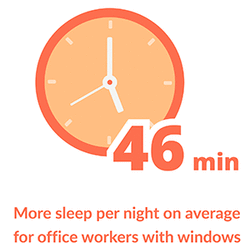Daylighting in Healthcare Facilities

In our last two articles about daylighting we looked at the advantages of daylighting in general and also in a school environment more specifically. Now take a moment to close your eyes and imagine a typical hospital room. Much like your average classroom, hospital rooms tend to be impersonal and harsh – fluorescent lights, off-white walls, and small windows – if any. This uniform design is likely due to the fact that hospital rooms are made to be functional more than anything. They are created to be easier to clean and offer few distractions for employees. However, research suggests that daylighting should be considered in the design of hospital rooms, as an effective daylighting strategy has a multitude of benefits for both patients and employees.
Daylighting and Patients
A patient’s mood is incredibly dependent on their exposure to natural light. If a person is in a dismal room, it only stands to reason that their mood will be affected for the worse. If a room is sunny and cheerful, the patient’s mood is likely to be better. Effective daylighting cuts rates of patient depression during long-term hospital stays [1]. This is especially important in hospitals treating patients with a history of depression, as it will prevent relapses into low moods, which hinder healing. According to World Health Design and psychologist Lucy Maddox, mood and healing are both bolstered if the windows also offer a view [2,3].
Patients in rooms that receive more natural light also tend to need less pain medication. According to one study, which explored the relationship between healing and sunlight, patients that received 46% more sunlight than the control group needed 22% less pain medication [4]. This not only cuts costs for the hospital, it also spares the patient possible side-effects of a higher dosage of medication. That is, patients who use less pain medication are less likely to form a dependence on it physically or psychologically, or experience side-effects that would require treatment.
According to recent studies, patients in naturally well-lit rooms actually heal faster and require a shorter hospital stay than patients without proper exposure to natural light. One study found that patients in sunnier rooms had stays that were 16%-41% shorter than patients located in dull rooms [4]. This increases turnover rates for hospitals, allowing them to serve more patients. It should also be noted that the mortality rates in intensive care units are lower in rooms that receive plenty of sunlight.
Daylighting and Nurses
Nurses work in a stressful environment and work through incredibly delicate situations daily. These men and women, quite literally, hold the lives of their patients in their hands. If their concentration slips for even a moment, the results could be disastrous. This is merely one reason why daylighting should be considered in hospitals. Individuals who receive enough exposure to natural light during the day are more likely to stay concentrated on the job [5]. Mistakes – such as errors when giving medication to patients, errors on paperwork, etc. – were made far less often when individuals received enough exposure to natural light [6]. Obviously, this reduction of mistakes is incredibly desirable.
Nurses who are exposed to sunlight in the workplace have, on average, better relationships with their coworkers and are more likely to maintain a good mood over long, stressful shifts [6]. They have a more positive outlook, too. This is incredibly important in such a stressful and, at times, morose position. Nurses who have a more positive attitude tend to be incredibly efficient and are able to react faster to problems that arise. In addition to these aspects, nurses who get enough sunlight are even apt to laugh more [7 ]!This mood-elevating effect of daylighting makes the hospital environment much more comfortable for nurses, allowing them to be at the top of their game.
This elevated mood also allows nurses to deliver a higher quality for care. Imagine if you were in the hospital and the nurse came in with a cheery smile – it is only common sense that patients prefer a nurse with a sunny disposition to one with a severe one. Nurses who receive enough sunlight tend to engage more with their patients [8], which in turn makes the patients feel that their quality of care is better. Happier nurses lead to happier patients, and happier patients have shorter stays [9] – which not only lends to a hospital’s reputation, but also cuts operating costs.
The factors explored should make it very evident – daylighting is incredibly important to the efficiency of hospitals and the well-being of their occupants. Correct implementation of daylighting techniques would not only reduce operating costs, but also make the environment much more inviting and friendly. If you’re interested in developing a daylighting strategy, Suntuitive Dynamic Glass can help! Visit www.Suntuitive.com or call 616.662.7216 for more information or to order your free Suntuitive Starter Kit.
Also: be sure to connect with us on LinkedIn or Facebook to not miss out on future article in this series on daylighting! We appreciate you as our audience.
Literature:
1.https://www.healthdesign.org/sites/default/files/CHD_Issue_Paper2.pdf
2.https://www.minnpost.com/second-opinion/2014/12/hospital-design-can-have-noticeable-effects-patient-health
3.http://www.designingbuildings.co.uk/wiki/Daylight_benefits_in_healthcare_buildings
4.https://www.academia.edu/5301109/Survey_of_Hospitals_Lighting_Daylight_and_Staff_Preferences
5.http://www.news.cornell.edu/stories/2014/07/sunny-side-nurses-dispense-better-care
6.http://www.medicalnewstoday.com/articles/280721.php
7.https://www.academia.edu/696902/_HEALING_ARCHITECTURE_DAYLIGHT_IN_HOSPITAL_DESIGN
Consulted, not referenced above:
1.http://www.gbbn.com/pub/docs/Daylight_HC.pdf
2.http://jrs.sagepub.com/content/91/7/352.abstract
3.http://www.nbbj.com/ideas/2013/3/19/let-there-be-light/
4.http://www.webmd.com/brain/news/20140814/employees-benefit-from-natural-light-study-finds
5.http://wilsonquarterly.com/stories/illuminating-many-benefits-natural-light/
6.http://articles.mercola.com/sites/articles/archive/2013/12/26/hospital-room-lighting.aspx
7.http://www.takingcharge.csh.umn.edu/explore-healing-practices/healing-environment/what-happening-healthcare-settings-today
8.http://www.ncbi.nlm.nih.gov/pmc/articles/PMC4040281/
9.http://www.cleveland.com/healthfit/index.ssf/2013/10/cleveland_clinic_study_changing_light_patterns_in_hospital_rooms_may_ease_patients_pain_and_fatigue.html
10.http://www.reuters.com/article/us-hospital-lighting-idUSBRE9A516120131106
11.http://www.ncbi.nlm.nih.gov/books/NBK2633/




